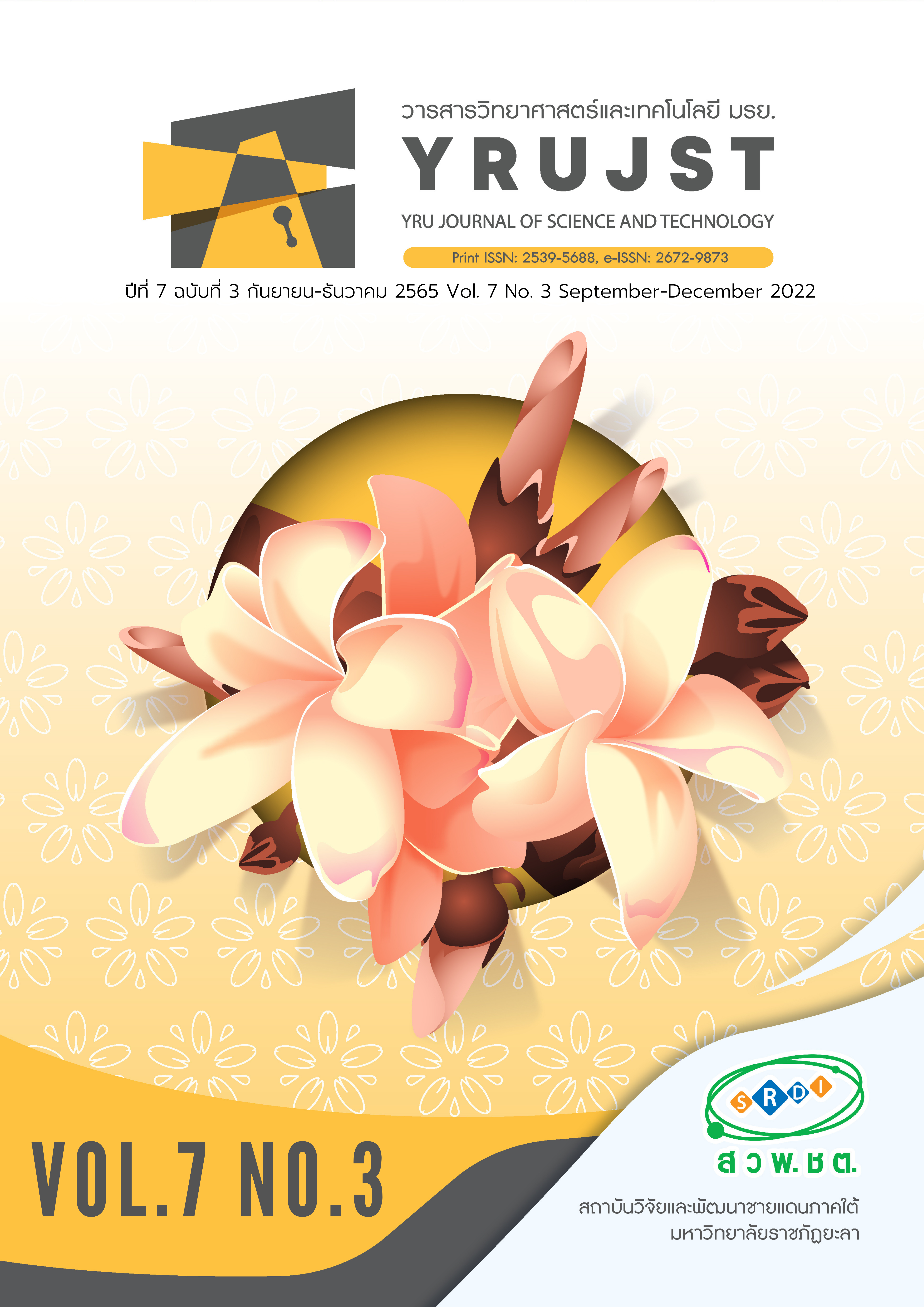การพัฒนาเครื่องดื่มน้ำข้าวหมากจากข้าวไรซ์เบอร์รี่และข้าวกล้องเกรดต่ำในจังหวัดฉะเชิงเทรา
Main Article Content
บทคัดย่อ
งานวิจัยนี้มีวัตถุประสงค์เพื่อนำข้าวสารหักที่ตกเกรด ซึ่งเป็นวัตถุดิบทางการเกษตรที่มีมากในจังหวัดฉะเชิงเทรา มาพัฒนาเป็นเครื่องดื่มชนิดใหม่จากข้าวหมาก โดยศึกษาข้าวเหนียวหักต่อข้าวไรซ์เบอร์รี่หักในอัตราส่วน 100:0 0:100 50:50 70:30 และ 90:10 w/w และข้าวเหนียวหักต่อข้าวกล้องหักในอัตราส่วน 100:0 0:100 50:50 70:30 และ 90:10 w/w และทดสอบคุณภาพทางประสาทสัมผัสและความชอบโดยรวมของผู้บริโภค และศึกษาฤทธิ์ทางชีวภาพของน้ำข้าวหมากในสูตรต่าง ๆ ได้แก่ ฤทธิ์ต้านอนุมูลอิสระ ปริมาณฟีนอลิก ปริมาณแอนโทไซยานิน และคุณภาพกายภาพ-เคมี ผลการทดลองพบว่า ข้าวหมากที่ผลิตจากข้าวเหนียวหักต่อข้าว ไรซ์เบอร์รี่หักในอัตราส่วน 70:30 และ 90:10 w/w ได้คะแนนความชอบโดยรวมสูงสุดไม่แตกต่างกันทางสถิติ (P>0.05) คือ 7.47 และ 7.46 ตามลำดับ โดยน้ำข้าวหมากที่ผลิตจากข้าวเหนียวหักต่อข้าวไรซ์เบอร์รี่หักในอัตราส่วน 70:30 w/w มีฤทธิ์ต้านอนุมูลอิสระ 42.58 % กรดฟีนอลิก 220.73 mg GAE/g และแอนโทไซยานิน 245.56 mg/l สูงสุดและได้รับคะแนนความชอบโดยรวมในระดับชอบปานกลาง ดังนั้นจึงคัดเลือกน้ำข้าวหมากที่ผลิตจากข้าวเหนียวหักต่อข้าวไรซ์เบอร์รี่หักที่อัตราส่วน 70:30 w/w ผลิตน้ำข้าวหมากและตรวจสอบคุณภาพของน้ำข้าวหมากตามมาตรฐาน มผช.162/2546. ผลการทดสอบคุณภาพไม่พบเชื้อก่อโรคในน้ำข้าวหมากและเป็นไปตามมาตรฐานผลิตภัณฑ์ มผช.162/2546
Article Details

อนุญาตภายใต้เงื่อนไข Creative Commons Attribution-NonCommercial-NoDerivatives 4.0 International License.
บทความ ข้อมูล เนื้อหา รูปภาพ ฯลฯ ที่ได้รับการเผยแพร่ในวารสารวิทยาศาสตร์และเทคโนโลยี มรย. นี้ ถือเป็นลิขสิทธิ์ของวารสารวิทยาศาสตร์และเทคโนโลยี มรย. หากบุคคลหรือหน่วยงานใดต้องการนำทั้งหมดหรือส่วนหนึ่งส่วนใดไปเผยแพร่ต่อหรือกระทำการใดๆ จะต้องได้รับอนุญาตเป็นลายลักษณ์อักษรจากวารสารวิทยาศาสตร์และเทคโนโลยี มรย. ก่อนเท่านั้น
เอกสารอ้างอิง
AOAC. (2019). Official Methods of Analysis of the Association of Official Analysis Chemistry International (21st Ed.). Arlington, Virginia: The Association of Official Analytical Chemists.
Jirasatid, S. & Nopharatana, M. (2018). Product development of sweet fermented rice (Khao-Mak) supplemented with red yeast rice. International Journal of Agricultural Technology, 14(4), 521-534.
Jirasatid, S. & Nopharatana, M. (2021). Thermal kinetics of gamma-aminobutyric acid and antioxidant activity in germinated red Jasmine Rice Milk using arrhenius, eyring-polanyi and ball models. Current Research in Nutrition and Food Science, 9(2), 700-711.
Mongkontanawat, N. & Lertnimitmongkol, W. (2015). Product development of sweet ferment rice (Khao-Mak) from germinated Native Black Rice. International Journal of Agricultural Technology, 11, 501-515.
Pitija, K., Nakornriab, M., Sriseadka, T., Vanavichit, A. & Wongpornchai, S. (2013). Anthocyanin content and antioxidant capacity in bran extracts of some Thai Black Rice Varieties. International Journal of Food Science & Technology, 48, 300-308.
Plaitho, Y., Kangsadalampai, K. & Sukprasansap, M. (2013). The protective effect of Thai fermented pigmented rice on urethane induced somatic mutation and recombination in Drosophila melanogaster. Journal of Medicinal plants Research, 7(2), 91-98.
Polthum, P. & Ahromrit, A. (2014). GABA content and antioxidant activity of Thai waxy corn seeds germinated by hypoxia method. Songklanakarin Journal of Science and Technology, 36(3), 309-316.
Srisuk, N., Montira, N. & Sani, J. (2021). Co-encapsulation of Dictyophora indusiate to improve Lactobacillus acidophilus survival and its effect on quality of sweet fermented rice (Khoa-Mak) sap beverage. Journal of Food Science and Technology, 58(9), 3598-3610.
Seeloy-ounkaew, T. & Buddhaboon, C. (2018). Land use and diversity of planting rice varieties in Chachoengsao Province. Journal of Agricultural Research and Extension, 35(2), 11-23. (in Thai)
Wongsa, J., Rungsardthong, V. & Yasutomo, T. (2018). Production and analysis of volatile flavor compounds in sweet fermented rice (Khao Mak). LWT-Food Science and Technology, 91, 192-196.
Yamuangmorn, S. & Prom-u-Thai, C. (2021). The potential of high-anthocyanin purple rice as a functional ingredient in human health. Antioxidants, 10, 1-21.


